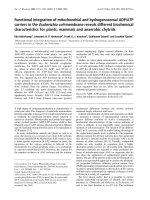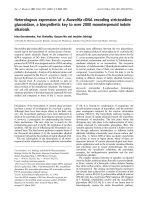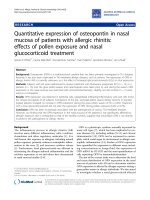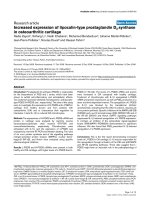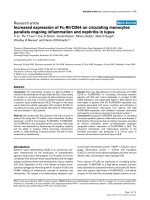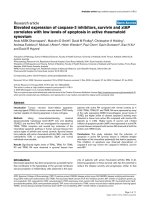Báo cáo y học: "Impaired expression of mitochondrial and adipogenic genes in adipose tissue from a patient with acquired partial lipodystrophy (Barraquer-Simons syndrome): a case report" pot
Bạn đang xem bản rút gọn của tài liệu. Xem và tải ngay bản đầy đủ của tài liệu tại đây (232.39 KB, 6 trang )
BioMed Central
Page 1 of 6
(page number not for citation purposes)
Journal of Medical Case Reports
Open Access
Case report
Impaired expression of mitochondrial and adipogenic genes in
adipose tissue from a patient with acquired partial lipodystrophy
(Barraquer-Simons syndrome): a case report
Jordi P Guallar
1
, Ricardo Rojas-Garcia
2
, Elena Garcia-Arumi
3
,
JoanCDomingo
1
, Eduardo Gallardo
2
, Antoni L Andreu
4
, Pere Domingo
4
,
Isabel Illa
2
, Marta Giralt
1
and Francesc Villarroya*
1
Address:
1
Departament de Bioquímica i Biologia Molecular and Institut de Biomedicina (IBUB), Universitat de Barcelona, and CIBER
Fisiopatologia Obesidad y Nutrición, Instituto de Salud Carlos III, Avda Diagonal 645, 08028, Barcelona, Spain,
2
Servei de Neurologia, Hospital
de la Santa Creu i Sant Pau, Antoni Ma Claret 167, 08025, Barcelona, Spain,
3
Departament de Patologia Mitocondrial i Neuromuscular, Institut
de Recerca, Hospital Universitari Vall d'Hebron, Pg. Vall d'Hebron 119-129, 08035, Barcelona, Spain and
4
Servei de Medicina Interna, Hospital
de la Santa Creu i Sant Pau, Antoni Ma Claret 167, 08025, Barcelona, Spain
Email: Jordi P Guallar - ; Ricardo Rojas-Garcia - ; Elena Garcia-Arumi - ;
Joan C Domingo - ; Eduardo Gallardo - ; Antoni L Andreu - ;
Pere Domingo - ; Isabel Illa - ; Marta Giralt - ; Francesc Villarroya* -
* Corresponding author
Abstract
Introduction: Acquired partial lipodystrophy or Barraquer-Simons syndrome is a rare form of
progressive lipodystrophy. The etiopathogenesis of adipose tissue atrophy in these patients is
unknown.
Case presentation: This is a case report of a 44-year-old woman with acquired partial
lipodystrophy. To obtain insight into the molecular basis of lipoatrophy in acquired partial
lipodystrophy, we examined gene expression in adipose tissue from this patient newly diagnosed
with acquired partial lipodystrophy. A biopsy of subcutaneous adipose tissue was obtained from
the patient, and DNA and RNA were extracted in order to evaluate mitochondrial DNA
abundance and mRNA expression levels.
Conclusion: The expression of marker genes of adipogenesis and adipocyte metabolism, including
the master regulator PPAR
γ
, was down-regulated in subcutaneous adipose tissue from this patient.
Adiponectin mRNA expression was also reduced but leptin mRNA levels were unaltered. Markers
of local inflammatory status were unaltered. Expression of genes related to mitochondrial function
was reduced despite unaltered levels of mitochondrial DNA. It is concluded that adipogenic and
mitochondrial gene expression is impaired in adipose tissue in this patient with acquired partial
lipodystrophy.
Introduction
Acquired partial lipodystrophy (APL) or Barraquer-
Simons syndrome is a rare form of progressive lipodystro-
phy (OMIM 60879). Patients show a progressive and sym-
Published: 27 August 2008
Journal of Medical Case Reports 2008, 2:284 doi:10.1186/1752-1947-2-284
Received: 7 February 2008
Accepted: 27 August 2008
This article is available from: />© 2008 Guallar et al; licensee BioMed Central Ltd.
This is an Open Access article distributed under the terms of the Creative Commons Attribution License ( />),
which permits unrestricted use, distribution, and reproduction in any medium, provided the original work is properly cited.
Journal of Medical Case Reports 2008, 2:284 />Page 2 of 6
(page number not for citation purposes)
metrical lipoatrophy of subcutaneous adipose tissue
starting from the face and spreading to the upper part of
the body. Other alterations, such as nephropathy or cen-
tral nervous system abnormalities, are often, but not
always, present [1]. Patients without any associated
anomalies or medical complications have also been
reported [2]. Women are more often affected than men
and most of the reported cases appear to be sporadic [3].
However, the appearance of similarly affected relatives in
the families of several patients has suggested autosomal
dominant inheritance [1,4]. Recently, through a study of
35 cases and extensive review of the literature, Garg and
collaborators established a major diagnostic criterion for
APL as being gradual onset of bilaterally symmetrical loss
of subcutaneous fat from the face, neck, upper extremities
and abdomen sparing the lower extremities [5]. It has
been reported recently that some cases of APL are associ-
ated with mutations in the lamin B gene [6], which is rem-
iniscent of other lipodystrophies, such as Dunnigan-type
familial partial lipodystrophy type 2, which are associated
with lamin A mutations [7]. However, the precise mecha-
nisms leading to adipose tissue atrophy in the syndrome
remain unknown. Here we present a patient with typical
APL and, to obtain insight into the potential etiopatho-
genic events leading to lipoatrophy in the disease, a gene
expression analysis of subcutaneous adipose tissue is
reported. The profile of gene expression is compared to
the gene expression pattern in subcutaneous fat from
healthy control individuals. This study focused on the
analysis of the expression of genes characteristic of the
adipocyte phenotype, as well as of genes involved in mito-
chondrial function and local inflammation status in adi-
pose tissue, whose expression is known to be disturbed in
experimental models of lipoatrophy as well as in lipodys-
trophy associated with antiretroviral treatment in patients
with HIV.
Case presentation
The patient was a Caucasian woman from Spain, and who
was the first child of non-consanguineous, healthy par-
ents. The neonatal period and her psychomotor develop-
ment were normal. She had her first menstruation at the
age of 13 years, and regularly since then. She has one child
following a normal pregnancy history. At age 8 years, she
noted that her subcutaneous adipose facial tissue gradu-
ally began to decrease and she complained of generalized
muscle pain, predominantly in her lower legs, after exer-
cise. The patient was first seen at age 44 years, this being
the time at which adipose tissue biopsy was conducted
(see below). A physical examination revealed generalized
and symmetrical loss of subcutaneous fatty tissue, pre-
dominantly in her face and the upper part of her body.
The facial lipoatrophy gave an impression of ageing, and
a male aspect was noted. However, testosterone levels
were normal (0.34 ng/ml, normal range from 0.3 to 1.2
ng/ml). Blood examination showed normal levels of glu-
cose (98 mg/dl, normal range 45 to 135 mg/dl), whereas
levels of triglycerides were higher than normal (252 mg/
dl, normal range 35 to 150 mg/dl) and levels of choles-
terol slightly higher than normal (234 mg/dl, normal
range 100 to 220 mg/dl). However, unaltered levels of
HDL-cholesterol (47 mg/dl, normal range 35 to 80 mg/
dl) and LDL-cholesterol (137 mg/dl, normal range 60 to
150 mg/dl) were found. The blood examination also
revealed normal muscular enzyme levels. A neurological
examination indicated that deep tendon reflexes were
normal and no myotonic phenomena were observed.
Nerve conduction studies showed normal values in all
tested nerves. A concentric needle examination showed
complex repetitive discharges in all tested muscles with no
spontaneous activity. Renal and liver function were, as
inferred from serum enzyme levels, also normal (ALT/
GPT 34 U/liter, normal range 2 to 41 U/liter; AST 27 U/
liter, normal range 1 to 40 U/liter; GGT 24 U/liter, normal
range 5 to 49 U/liter). Ultrasonic examination of the
abdomen indicated hepatic steatosis with normal liver
size and morphology, and the kidneys and spleen were
normal. Cytogenetic studies revealed a normal karyotype
(46XX) without evidence of chromosome breakage.
Serum C3 levels were 45 mg/dL, which was abnormally
low with respect to normal values (range from 85 to 180
mg/dl). Results were positive for the presence of serum
complement 3 nephritic factor. Thus, the overall clinical
and biochemical features of the patient led to the diagno-
sis of APL. The pattern of progressive loss of subcutaneous
adipose tissue in the face and the upper part of the body
was in accordance with the major criterion established by
Misra et al. (2004) [5] and supportive criteria were also
met: onset during childhood, low serum levels of comple-
ment 3 and the presence of serum complement 3
nephritic factor.
A biopsy sample of subcutaneous adipose tissue was taken
from the arm. Control values of gene expression in adi-
pose tissue were obtained from the analysis of biopsies of
subcutaneous adipose tissue taken from the arms of 10
healthy control individuals (mean age 38.5 ± 9.0 years, 4/
6 female/male). The patient and the individual controls
gave their consent to participate in the study and the pro-
tocol was approved by the Ethics Committee of the Hos-
pital de la Santa Creu i Sant Pau, Barcelona, Spain.
Separate analysis of gene expression markers in men and
women did not show any significant difference and there-
fore reference values of gene expression in healthy men
and women were shown together. After homogenization
in RLT buffer (Qiagen, Hilden. Germany), an aliquot was
used for isolation of DNA, which was performed using a
standard phenol/chloroform extraction methodology.
Another aliquot of the homogenate was used for RNA
extraction using a column-affinity based methodology
Journal of Medical Case Reports 2008, 2:284 />Page 3 of 6
(page number not for citation purposes)
(RNEasy, Qiagen, Hilden, Germany). For mRNA analysis
TaqMan Reverse Transcription and -RT-PCR reagents were
used (Applied Biosystems, Foster City, CA, USA). One
microgram of RNA was transcribed into cDNA using ran-
dom-hexamer primers and real-time reverse transcriptase-
polymerase chain reaction (RT-PCR) was performed on
an ABI PRISM 7700HT sequence detection system. The
TaqMan RT-PCR was performed in a final volume of 25 μl
using TaqMan Universal PCR Master Mix, NoAmpErase
UNG reagent and the specific gene expression primer
probes. The TaqManGene Expression assays used were:
COX4I1 (subunit IV of cytochrome c oxidase, COIV),
Hs00266371_m1; ATPase5J (subunit F6 of F0-ATPsyn-
thase) Hs0036588_m1; PPARGC1 (PGC-1
α
),
Hs0013304_m1; CEBPA (CCAAT/enhancer binding pro-
tein-α, C/EBBP-
α
), Hs00269972_s1; PPARG (peroxi-
some-proliferator activated receptor-γ, PPAR-
γ
),
Hs00234592_m1; RB1 (retinoblastoma protein, pRB),
Hs00153108_m1; DLK1 (Pref-1), Hs00171584_m1;
UCP2 (uncoupling protein-2, UCP-2), Hs00163349_m1;
UCP3 (uncoupling protein-3, UCP-3), Hs00243297_m1;
NRF1 (nuclear respiratory factor-1, NRF-1)
Hs00192316_m1; LPL (lipoprotein lipase, LPL),
Hs00173425_m1; LEP (leptin, LEP), Hs00174877_m1;
Complement precursor-3, Hs00163811_m1; TNF (tumor
necrosis factor-α, TNF-
α
), Hs00174128_m1; SLC2A4
(glucose transporter, GLUT4), Hs00168966_m1; APM1
(adiponectin), Hs00605917_m1; β2-microglobulin,
Hs9999907_m1; MCP-1 (monocyte chemoattractant pro-
tein-1, MCP-1), Hs00234140_m1; CD68 antigen,
Hs00154355. Primers and probe for the detection of cyto-
chrome c oxidase subunit II (COII) mRNA and mtDNA
abundance were designed as previously reported [8]. Con-
trols with no RNA, primers, or reverse transcriptase were
included in each set of experiments. Each sample was run
in duplicate and the amount of mRNA for the gene of
interest in each sample was normalized to that of the ref-
erence control using the comparative (2
-ΔCT
) method.
Data for gene transcripts are expressed as the ratio of rela-
tive abundance of the mRNA of the gene of interest respect
to 18S rRNA (Hs99999901_s1).
Examination of gene expression for master regulatory fac-
tors associated with the promotion of adipogenesis indi-
cated that peroxisome proliferator-activated-γ (PPAR
γ
)
mRNA was the only mRNA significantly down-regulated
in the patient with APL with respect to controls (Table 1).
The expression of mRNA for another positive regulator of
adipogenesis, CCAAT/enhancer binding protein-α (C/
EBP
α
) mRNA was not significantly altered. The mRNA
levels of retinoblastoma protein pRb, a protein that may
have negative effects on adipogenesis [9], and of Pref-1, a
known negative regulator of adipogenesis [10] were also
unchanged. Among adipokines, leptin mRNA levels were
unaltered in the patient whereas adiponectin mRNA was
down-regulated. The mRNA for two marker genes of adi-
pose tissue metabolism, insulin-sensitive glucose trans-
porter-4 (GLUT4) and lipoprotein lipase (LPL), were also
down-regulated in the patient with respect to controls. In
contrast, the mRNA levels for three marker genes of
inflammation (tumor necrosis factor-α, TNF
α
; MCP-1;
and β2-microglobulin) as well as the marker of macro-
phage infiltration CD68 were unaltered in the patient,
with values almost identical to those of controls. Comple-
ment component-3 gene expression was also unchanged.
Levels of transcripts corresponding to components of the
respiratory chain system (OXPHOS), either mtDNA-
encoded (COII) or nuclear DNA-encoded (COIV and ATP
synthase F0 subunit 6) were reduced in adipose tissue from
the patient with respect to healthy controls. No significant
changes were observed for mtDNA abundance in adipose
tissue from the patient with respect to reference control
values (1.08-fold change with respect to the mean control
values). Neither UCP2 mRNA levels nor UCP3 mRNA lev-
els were altered in the patient relative to controls. Like-
wise, transcript levels for PPARγ-coactivator-1α (PGC-1
α
)
and nuclear respiratory factor-1 (NRF-1), regulatory fac-
tors of mitochondrial biogenesis, were also unaltered in
the patient with respect to controls.
Discussion
The present study constitutes the first gene expression
analysis in adipose tissue from a patient with APL lipod-
ystrophy syndrome and, to our knowledge, the first gene
expression analysis of any lipodystrophy disease other
than that in highly active antiretroviral-treated (HAART)
patients infected with HIV. A clear limitation of the
present type of study is that cause-and-effect relationships
cannot be established and the observed changes in gene
expression could be either a cause or consequence of the
alteration in adipose tissue. However, identification of the
genes showing altered expression may provide clues for
further research into the etiopathogenesis of the disease.
The results indicated that adipose tissue of the patient
with APL showed impaired expression of genes associated
with the adipocyte differentiation process and this
involves genes related to adipose tissue metabolism and
PPAR
γ
, a master regulatory gene of adipogenesis. The
down-regulation of PPAR
γ
may be the main causative
event of the coordinate impairment in the expression of
genes encoding components of adipocyte metabolism or
adipokines, as genes such as GLUT4, LPL, and the adi-
ponectin gene are known targets of PPAR
γ
-dependent reg-
ulation [11]. PPARγ deficiency due to either
haploinsufficiency or to dominant negative activity elicits
familial partial lipodystrophy (Dunnigan) type 3 [12]
whereas reduced PPAR
γ
expression has been observed in
fat from patients with HAART-associated lipodystrophy
Journal of Medical Case Reports 2008, 2:284 />Page 4 of 6
(page number not for citation purposes)
[13,14]. It appears therefore that lowered PPARγ activity,
regardless of its origin, may be common to multiple types
of lipodystrophy. However, it cannot be excluded that
PPARγ down-regulation is an effect, and not a primary
cause of the APL syndrome, just as lowered PPARγ gene
expression is commonly found in adipose tissue from
patients with distinct pathologies leading to lipoatrophy.
On the other hand, the absence of a reduction in mRNA
for C/EBPα, another master regulator of adipogenesis,
does not support an overall impairment of adipogenesis
in patients with APL. Unaltered leptin gene expression is
consistent with previous observations in patients with
APL showing that most of these patients have unaltered
circulating levels of leptin [5].
A major difference in the alterations observed in adipose
tissue from our patient with respect to subcutaneous fat
from lipodystrophic HAART patients concerns marker
genes of inflammation. Whereas in HAART patients, the
expression of genes related to inflammatory processes are
systematically up-regulated [13-15], gene expression for
the four markers of inflammation analyzed here is com-
pletely normal in our patient. This result does not indicate
a major involvement of an inflammatory environment in
adipose tissue as causative of lipoatrophy in APL syn-
drome. However, a wider analysis of markers of inflam-
mation covering the distinct manifestations of the
inflammatory process would be required for unequivocal
evaluation of the role of inflammation in adipose tissue of
patients with APL.
A remarkable finding in this study is the identification of
reduced expression of genes for mitochondrial respiratory
chain components in adipose tissue from our patient with
APL. Mitochondrial impairment has been previously
identified in HAART-associated lipodystrophy and it was
first attributed to the toxicity of some antiretroviral drugs
which cause mitochondrial DNA depletion [16]. How-
ever, recent data have established that mitochondrial
impairment is a more general phenomenon associated
with HAART lipoatrophy, which also involves causative
events other than mtDNA depletion [14,17]. The present
Table 1: mRNA expression of genes involved in adipogenesis, metabolism, inflammation and mitochondrial function in adipose tissue
from our patient with APL
Healthy controls APL Change
Adipogenesis (+)
PPAR
γ
mRNA 2.78 (1.81–3.74) × 10
-5
1.35 × 10
-5
↓
C/EBP
α
mRNA 1.55 (0.93–2.03) × 10
-4
1.66 × 10
-4
=
Adipogenesis (-)
pRb mRNA 7.52 (3.47–11.57) × 10
-6
3.84 × 10
-6
=
Pref-1 mRNA 0.44 (0.03–0.84) × 10
-9
0.04 × 10
-9
=
Adipokines
Leptin mRNA 0.73 (0.41–1.02) × 10
-4
0.85 × 10
-4
=
Adiponectin mRNA 1.05 (0.69–1.39) × 10
-3
0.49 × 10
-3
↓
Metabolism
GLUT4 mRNA 0.96 (0.43–1.47) × 10
-5
0.13 × 10
-6
↓
LPL mRNA 2.88 (2.15–3.47) × 10
-4
0.73 × 10
-4
↓
Inflammation
TNF
α
mRNA 5.18 (2.74–7.63) × 10
-7
4.56 × 10
-7
=
MCP-1 mRNA 0.24 (0.07–0.40) × 10
-5
0.19 × 10
-5
=
β2-microglobulin mRNA 2.85 (2.06–3.49) × 10
-4
3.12 × 10
-4
=
CD68 mRNA 0.75 (0.26–1.24) × 10
-4
1.01 × 10
-4
=
Complement system
Component 3 mRNA 1.99 (0.91–3.07) × 10
-4
2.08 × 10
-4
=
OXPHOS
COII mRNA 1.17 (0.74–1.51) × 10
-2
0.35 × 10
-2
↓
COIV mRNA 4.24 (3.42–4.81) × 10
-5
1.55 × 10
-5
↓
ATPsynthase F0-6 mRNA 6.77 (4.85–8.69) × 10
-5
2.10 × 10
-5
↓
UCPs
UCP2 mRNA 4.05 (2.74–5.77) × 10
-5
5.72 × 10
-5
=
UCP3 mRNA 4.13 (1.67–6.50) × 10
-7
2.56 × 10
-7
=
Mitochondriogenesis regulators
PGC-1
α
mRNA 1.12 (0.71–1.51) × 10
-6
0.82 × 10
-6
=
NRF-1 mRNA 4.06 (2.96–5.26) × 10
-6
3.37 × 10
-6
=
APL, Acquired partial lipodystrophy. Values of mRNA expression in adipose tissue from healthy controls are shown as means (95% confidence
interval in parentheses), expressed as the ratio of relative abundance of the mRNA of the gene of interest relative to 18S rRNA. Reduced mRNA
expression values in APL below confidence intervals are shown as ↓.
Journal of Medical Case Reports 2008, 2:284 />Page 5 of 6
(page number not for citation purposes)
findings identify for the first time mitochondrial distur-
bances in adipose tissue from a form of lipoatrophy unre-
lated to viral infection or antiretroviral treatment, and not
associated with mtDNA depletion. This indicates that
altered mitochondrial function might be a potential com-
mon disturbance in lipoatrophy regardless of its origin, a
possibility which deserves further research. Recent find-
ings have indicated a previously unrecognized role of
mitochondrial biogenesis in the adipocyte differentiation
process [18], and the present observations would fit with
mitochondrial impairment as being causative of
lipoatrophic phenomena. However, other events related
to mitochondrial disturbances, such as mutations in the
tRNALys gene of mitochondrial DNA, cause lipomatosis
rather than peripheral lipoatrophy [8] and therefore a
simple defective mitochondrial activity model cannot
solely account for eliciting atrophy in adipose tissue.
Conclusion
In summary, this is the first gene expression analysis in
adipose tissue from a patient with APL. It reveals impaired
gene expression for marker genes of adipogenesis, includ-
ing the master regulator PPAR
γ
, and mitochondrial func-
tion without signs of altered expression of inflammation-
related genes.
Abbreviations
18S rRNA: 18S ribosomal RNA; APL: Acquired partial
lipodystrophy (Barraquer-Simons syndrome); C/EBP-α:
CCAAT/enhancer binding protein-α; COIV: subunit IV of
cytochrome c oxidase; COII: subunit II of cytochrome c
oxidase; GLUT4: Glucose transporter-4; HAART: Highly
active antiretroviral-treatment; LPL: Lipoprotein lipase;
MCP-1: Monocyte chemoattractant protein-1; mtDNA:
Mitochondrial DNA; NRF1: Nuclear respiratory factor-1;
PGC-1α: peroxisome-proliferator activated receptor-γ co-
activator-1α; PPAR-
γ
: Peroxisome-proliferator activated
receptor-γ; pRB: retinoblastoma protein; Pref-1: Preadi-
pocyte factor-1; TNF-α: tumor necrosis factor-α; UCP2:
Uncoupling protein-2; UCP3: Uncoupling protein-3.
Competing interests
The authors declare that they have no competing interests.
Authors' contributions
PD and II analyzed and interpreted the data from the
physical examination of the patient and PD was a major
contributor in writing the manuscript. RRG, EG and II per-
formed the analysis and interpretation of data in relation
to renal and liver function, cytogenetic analysis and blood
analysis. EGA and ALA carried out muscle analysis. JCD
performed the analysis and interpretation of mitochon-
drial DNA data and JG and MG analyzed the mRNA. FV
designed and coordinated the study and was responsible
for final writing of the manuscript. All authors read and
approved the final manuscript.
Consent
Written informed consent was obtained from the patient
for publication of this case report. A copy of the written
consent is available for review by the Editor-in-Chief of
this journal.
Acknowledgements
Supported by Ministerio de Educación y Ciencia (grant SAF2005-01722)
and Fondo de Investigaciones Sanitarias Ministerio de Sanidad y Consumo
(grant PI052336), Spain.
References
1. Senior B, Gellis SS: The syndromes of total lipodystrophy and
of partial lipodystrophy. Pediatrics 1964, 33:593-612.
2. Ferrarini A, Milani D, Bottigelli M, Cagnoli G, Selicorni A: Two new
cases of Barraquer-Simons syndrome. Am J Med Genet A 2004,
126:427-429.
3. Bier DM, O'Donnell JJ, Kaplan SL: Cephalothoracic lipodystrophy
with hypocomplementemic renal disease: discordance in
identical twin sisters. J Clin Endocrinol Metab 1978, 46:800-807.
4. Power DA, Ng YC, Simpson JG: Familial incidence of C3
nephritic factor, partial lipodystrophy and membranoprolif-
erative glomerulonephritis. Q J Med 1990, 75:387-398.
5. Misra A, Peethambaram A, Garg A: Clinical features and meta-
bolic and autoimmune derangements in acquired partial
lipodystrophy: report of 35 cases and review of the litera-
ture. Medicine (Baltimore) 2004, 83:18-34.
6. Hegele RA, Cao H, Liu DM, Costain GA, Charlton-Menys V, Rodger
NW, Durrington PN: Sequencing of the reannotated LMNB2
gene reveals novel mutations in patients with acquired par-
tial lipodystrophy. Am J Hum Genet 2006, 79:383-389.
7. Jacob KN, Garg A: Laminopathies: multisystem dystrophy syn-
dromes. Mol Genet Metab 2006, 87:289-302.
8. Guallar JP, Vila MR, Lopez-Gallardo E, Solano A, Domingo JC, Gamez
J, Pineda M, Capablo JL, Domingo P, Andreu AL, Montoya J, Giralt M,
Villarroya F: Altered expression of master regulatory genes of
adipogenesis in lipomas from patients bearing tRNA(Lys)
point mutations in mitochondrial DNA. Mol Genet Metab 2006,
89:283.
9. Fajas L, Egler V, Reiter R, Hansen J, Kristiansen K, Debril MB, Miard
S, Auwerx J: The retinoblastoma-histone deacetylase 3 com-
plex inhibits PPARgamma and adipocyte differentiation. Dev
Cell 2002, 3:903-910.
10. Wang Y, Kim KA, Kim JH, Sul HS: Pref-1, a preadipocyte
secreted factor that inhibits adipogenesis. J Nutr 2006,
136:2953-2956.
11. Spiegelman BM, Choy L, Hotamisligil GS, Graves RA, Tontonoz P:
Regulation of adipocyte gene expression in differentiation
and syndromes of obesity/diabetes.
J Biol Chem 1993, 268:6823.
12. Hegele RA: Lessons from human mutations in PPARgamma.
Int J Obes (Lond) 2005, 29(Suppl 1):S31-S35.
13. Bastard JP, Caron M, Vidal H, Jan V, Auclair M, Vigoroux C, Luboinski
J, Laville M, Maachi M, Girard PM, Rozenbaum W, Levan P, Capeau J:
Association between altered expression of adipogenic factor
SREBP1 in lipoatrophic adipose tissue from HIV-1-infected
patients and abnormal adipocyte differentiation and insulin
resistance. Lancet 2002, 359:1026.
14. Giralt M, Domingo P, Guallar JP, Rodriguez de la Concepcion ML, Ale-
gre M, Domingo JC, Villarroya F: HIV-1 infection alters gene
expression in adipose tissue, which contributes to HIV-1/
HAART-associated lipodystrophy. Antivir Ther 2006, 11:729.
15. Johnson JA, Albu JB, Engelson ES, Fried SK, Inada Y, Ionescu G, Kotler
DP: Increased systemic and adipose tissue cytokines in
patients with HIV-associated lipodystrophy. Am J Physiol Endo-
crinol Metab 2004, 286:E261.
16. Villarroya F, Domingo P, Giralt M: Lipodystrophy associated with
highly active anti-retroviral therapy for HIV infection: the
Publish with BioMed Central and every
scientist can read your work free of charge
"BioMed Central will be the most significant development for
disseminating the results of biomedical research in our lifetime."
Sir Paul Nurse, Cancer Research UK
Your research papers will be:
available free of charge to the entire biomedical community
peer reviewed and published immediately upon acceptance
cited in PubMed and archived on PubMed Central
yours — you keep the copyright
Submit your manuscript here:
/>BioMedcentral
Journal of Medical Case Reports 2008, 2:284 />Page 6 of 6
(page number not for citation purposes)
adipocyte as a target of anti-retroviral-induced mitochon-
drial toxicity. Trends Pharmacol Sci 2005, 26:88.
17. Jones SP, Qazi N, Morelese J, Lebrecht D, Sutinen J, Yki-Jarvinen H,
Back DJ, Pirmohamed M, Gazzard BG, Walker UA, Moyle GJ:
Assessment of adipokine expression and mitochondrial tox-
icity in HIV patients with lipoatrophy on stavudine- and zido-
vudine-containing regimens. J Acquir Immune Defic Syndr 2005,
40:565.
18. Wilson-Fritch L, Nicoloro S, Chouinard M, Lazar MA, Chui PC,
Leszyk J, Straubhaar J, Czech MP, Corvera S: Mitochondrial
remodeling in adipose tissue associated with obesity and
treatment with rosiglitazone. J Clin Invest 2004, 114:1281.


